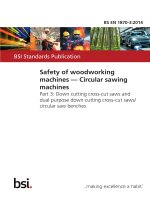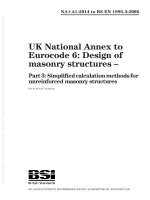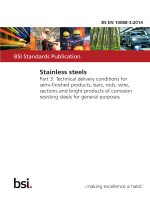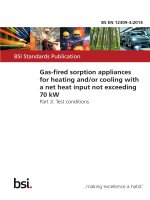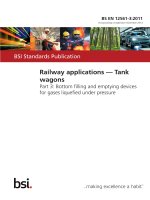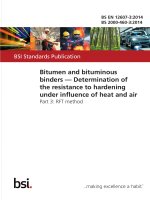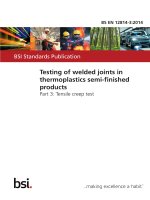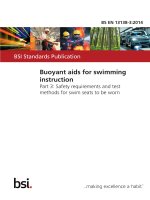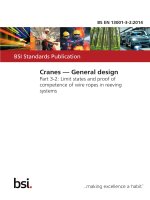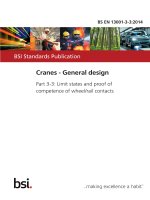Bsi bs en 61850 3 2014
Bạn đang xem bản rút gọn của tài liệu. Xem và tải ngay bản đầy đủ của tài liệu tại đây (1.68 MB, 74 trang )
BS EN 61850-3:2014
BSI Standards Publication
Communication networks
and systems for power
utility automation
Part 3: General requirements
BRITISH STANDARD
BS EN 61850-3:2014
National foreword
This British Standard is the UK implementation of EN 61850-3:2014. It
is identical to IEC 61850-3:2013. It supersedes BS EN 61850-3:2002
which is withdrawn.
The UK participation in its preparation was entrusted to Technical
Committee PEL/57, Power systems management and associated
information exchange.
A list of organizations represented on this committee can be obtained on
request to its secretary.
This publication does not purport to include all the necessary provisions of
a contract. Users are responsible for its correct application.
© The British Standards Institution 2014.
Published by BSI Standards Limited 2014
ISBN 978 0 580 74244 6
ICS 29.240.10; 33.040.40
Compliance with a British Standard cannot confer immunity from
legal obligations.
This British Standard was published under the authority of the
Standards Policy and Strategy Committee on 31 August 2014.
Amendments/corrigenda issued since publication
Date
Text affected
BS EN 61850-3:2014
EUROPEAN STANDARD
EN 61850-3
NORME EUROPÉENNE
EUROPÄISCHE NORM
July 2014
ICS 33.200
Supersedes EN 61850-3:2002
English Version
Communication networks and systems for power utility
automation - Part 3: General requirements
(IEC 61850-3:2013)
Réseaux et systèmes de communication pour
l'automatisation des systèmes électriques - Partie 3:
Exigences générales
(CEI 61850-3:2013)
Kommunikationsnetze und -systeme für die
Automatisierung in der elektrischen Energieversorgung Teil 3: Allgemeine Anforderungen
(IEC 61850-3:2013)
This European Standard was approved by CENELEC on 2014-01-16. CENELEC members are bound to comply with the CEN/CENELEC
Internal Regulations which stipulate the conditions for giving this European Standard the status of a national standard without any alteration.
Up-to-date lists and bibliographical references concerning such national standards may be obtained on application to the CEN-CENELEC
Management Centre or to any CENELEC member.
This European Standard exists in three official versions (English, French, German). A version in any other language made by translation
under the responsibility of a CENELEC member into its own language and notified to the CEN-CENELEC Management Centre has the
same status as the official versions.
CENELEC members are the national electrotechnical committees of Austria, Belgium, Bulgaria, Croatia, Cyprus, the Czech Republic,
Denmark, Estonia, Finland, Former Yugoslav Republic of Macedonia, France, Germany, Greece, Hungary, Iceland, Ireland, Italy, Latvia,
Lithuania, Luxembourg, Malta, the Netherlands, Norway, Poland, Portugal, Romania, Slovakia, Slovenia, Spain, Sweden, Switzerland,
Turkey and the United Kingdom.
European Committee for Electrotechnical Standardization
Comité Européen de Normalisation Electrotechnique
Europäisches Komitee für Elektrotechnische Normung
CEN-CENELEC Management Centre: Avenue Marnix 17, B-1000 Brussels
© 2014 CENELEC All rights of exploitation in any form and by any means reserved worldwide for CENELEC Members.
Ref. No. EN 61850-3:2014 E
BS EN 61850-3:2014
EN 61850-3:2014
-2-
Foreword
The text of document 57/1391/FDIS, future edition 2 of IEC 61850-3, prepared by IEC/TC 57 "Power
systems management and associated information exchange" was submitted to the IEC-CENELEC
parallel vote and approved by CENELEC as EN 61850-3:2014.
The following dates are fixed:
•
latest date by which the document has
to be implemented at national level by
publication of an identical national
standard or by endorsement
(dop)
2014-10-18
•
latest date by which the national
standards conflicting with the
document have to be withdrawn
(dow)
2017-01-16
This document supersedes EN 61850-3:2002.
Attention is drawn to the possibility that some of the elements of this document may be the subject of
patent rights. CENELEC [and/or CEN] shall not be held responsible for identifying any or all such
patent rights.
Endorsement notice
The text of the International Standard IEC 61850-3:2013 was approved by CENELEC as a European
Standard without any modification.
In the official version, for Bibliography, the following notes have to be added for the standards indicated:
IEC 60127-1
NOTE Harmonized as EN 60127-1.
IEC 60255-27:2005
NOTE Harmonized as EN 60255-27:2005 (not modified).
IEC 60297-3-101
NOTE Harmonized as EN 60297-3-101.
IEC 60721-3-3
NOTE Harmonized as EN 60721-3-3.
BS EN 61850-3:2014
EN 61850-3:2014
-3-
Annex ZA
(normative)
Normative references to international publications
with their corresponding European publications
The following documents, in whole or in part, are normatively referenced in this document and are
indispensable for its application. For dated references, only the edition cited applies. For undated
references, the latest edition of the referenced document (including any amendments) applies.
NOTE When an international publication has been modified by common modifications, indicated by (mod), the relevant EN/HD
applies.
Publication
Year
Title
EN/HD
Year
CISPR 22
2008
Information technology equipment - Radio
disturbance characteristics - Limits and
methods of measurement
CISPR 24
+ corr. June
2010
2011
Information technology equipment - Immunity EN 55024
characteristics - Limits and methods of
measurement
EN 60068-2-1
2007
Environmental testing Part 2-1: Tests - Test A: Cold
IEC 60068-2-2
2007
Environmental testing Part 2-2: Tests - Test B: Dry heat
EN 60068-2-2
2007
IEC 60068-2-14
2009
Environmental testing Part 2-14: Tests - Test N: Change of
temperature
EN 60068-2-14
2009
IEC 60068-2-30
2005
Environmental testing EN 60068-2-30
Part 2-30: Tests - Test Db: Damp heat, cyclic
(12 h + 12 h cycle)
2005
IEC 60068-2-78
2001
Environmental testing Part 2-78: Tests - Test Cab: Damp heat,
steady state
EN 60068-2-78
IEC 60255-21-1
Electrical relays Part 21: Vibration, shock, bump and seismic
tests on measuring relays and protection
equipment - Section 1: Vibration tests
(sinusoidal)
EN 60255-21-1
IEC 60255-21-2
Electrical relays EN 60255-21-2
Part 21: Vibration, shock, bump and seismic
tests on measuring relays and protection
equipment - Section 2: Shock and bump tests
IEC 60255-21-3
Electrical relays Part 21: Vibration, shock, bump and seismic
tests on measuring relays and protection
equipment - Section 3: Seismic tests
IEC 60255-27
2013
EN 55022
1)
+ AC:2011
2010
2011
2010
2)
2001
EN 60255-21-3
Measuring relays and protection equipment - EN 60255-27
Part 27: Product safety requirements
1)
EN 55022 is superseded by EN 50561-1:2013, which is based on .
2)
EN 60068-2-78 is superseded by EN 60068-2-78:2013, which is based on IEC 60068-2-78:2012.
2014
BS EN 61850-3:2014
EN 61850-3:2014
Publication
IEC 60417
Year
-4Title
EN/HD
data
base
HD 243 S12
Year
3) 4)
IEC 60529
Degrees of protection provided by enclosures (IP Code)
IEC 60664-1
Insulation coordination for equipment within
low-voltage systems Part 1: Principles, requirements and tests
IEC 60695-11-10
Fire hazard testing EN 60695-11-10
Part 11-10: Test flames - 50 W horizontal and
vertical flame test methods
IEC 60825-1
Safety of laser products Part 1: Equipment classification and
requirements
1995
-
EN 60664-1
EN 60825-1
IEC 60990
1999
Methods of measurement of touch current and EN 60990
protective conductor current
1999
IEC 61000-4-2
2008
Electromagnetic compatibility (EMC) EN 61000-4-2
Part 4-2: Testing and measurement
techniques - Electrostatic discharge immunity
test
2009
IEC 61000-4-3
2008
Electromagnetic compatibility (EMC) Part 4-3: Testing and measurement
techniques - Radiated, radio-frequency,
electromagnetic field immunity test
IEC 61000-4-4
+ corr. June
2004
2007
Electromagnetic compatibility (EMC) Part 4-4: Testing and measurement
techniques - Electrical fast transient/burst
immunity test
EN 61000-4-4
IEC 61000-4-5
+ corr. October
2005
2009
Electromagnetic compatibility (EMC) Part 4-5: Testing and measurement
techniques - Surge immunity test
EN 61000-4-5
IEC 61000-4-6
2008
Electromagnetic compatibility (EMC) Part 4-6: Testing and measurement
techniques - Immunity to conducted
disturbances, induced by radio-frequency
fields
EN 61000-4-6
IEC 61000-4-8
5)
2004
2006
6)
2009
2001
Electromagnetic compatibility (EMC) Part 4-8: Testing and measurement
techniques - Power frequency magnetic field
immunity test
IEC 61000-4-11
2004
Electromagnetic compatibility (EMC) EN 61000-4-11
Part 4-11: Testing and measurement
techniques - Voltage dips, short interruptions
and voltage variations immunity tests
2004
IEC 61000-4-16
2002
Electromagnetic compatibility (EMC) Part 4-16: Testing and measurement
techniques - Test for immunity to conducted,
common mode disturbances in the frequency
range 0 Hz to 150 kHz
3)
HD 243 S12 includes supplement(s) M to K to IEC 60417.
4)
HD 243 S12 is superseded by EN 60417-2:1999, which is based on IEC 60417-2:1998.
5)
EN 61000-4-4 is superseded by EN 61000-4-4:2012, which is based on IEC 61000-4-4:2012.
6)
EN 61000-4-6 is superseded by EN 61000-4-6:2014, which is based on IEC 61000-4-6:2013.
BS EN 61850-3:2014
EN 61850-3:2014
-5Publication
Year
Title
EN/HD
Year
IEC 61000-4-17
2009
Electromagnetic compatibility (EMC) Part 4-17: Testing and measurement
techniques - Ripple on d.c. input power port
immunity test
-
-
IEC 61000-4-18
2006
Electromagnetic compatibility (EMC) Part 4-18: Testing and measurement
techniques - Damped oscillatory wave
immunity test
EN 61000-4-18
+ corr. September
2007
2007
IEC 61000-4-29
2000
Electromagnetic compatibility (EMC) EN 61000-4-29
Part 4-29: Testing and measurement
techniques - Voltage dips, short interruptions
and voltage variations on d.c. input power port
immunity tests
2000
IEC 61010-1
+ corr. May
2010
2011
Safety requirements for electrical equipment EN 61010-1
for measurement, control and laboratory use Part 1: General requirements
2010
IEC 61180-1
1992
High-voltage test techniques for low-voltage
equipment Part 1: Definitions, test and procedure
requirements
EN 61180-1
1994
High-voltage test techniques for low-voltage
equipment Part 2: Test equipment
EN 61180-2
IEC 61180-2
IEC/TS 61850-2
2003
IEC 61850
(Series) Communication networks and systems in
EN 61850
substations Part 6: Configuration description language for
communication in electrical substations
related to IEDs
IEC 62271-1
Communication networks and systems in
substations Part 2: Glossary
High-voltage switchgear and controlgear Part 1: Common specifications
IEEE 1613
2009
ISO 780
1997
EN 62271-1
IEEE Standard Environmental and Testing
Requirements for Communications
Networking Devices Installed in Electric Power
Substations
Packaging - Pictorial marking for handling of EN ISO 780
goods
ISO 7000
Graphical symbols for use on equipment Registered symbols
ISO 9772
Cellular plastics - Determination of horizontal
burning characteristics of small specimens
subjected to a small flame
(Series)
1999
–2–
BS EN 61850-3:2014
61850-3 © IEC:2013
CONTENTS
1
Scope .............................................................................................................................. 7
2
Normative references ...................................................................................................... 7
3
Terms, definitions and abbreviations ............................................................................... 9
4
3.1
Terms and definitions ......................................................................................... 9
3.2
Abbreviations ................................................................................................... 20
Environmental conditions ............................................................................................... 20
5
4.1
General ............................................................................................................ 20
4.2
Normal environmental conditions ..................................................................... 20
4.3
Special environmental conditions ..................................................................... 21
4.4
Storage conditions ........................................................................................... 22
Ratings .......................................................................................................................... 22
5.1
5.2
6
General ............................................................................................................ 22
Rated voltage – Auxiliary energizing voltage .................................................... 22
5.2.1
AC voltage ...................................................................................... 22
5.2.2
DC voltage...................................................................................... 22
5.2.3
Operating range .............................................................................. 22
Binary input and output .................................................................................... 22
5.3
5.3.1
Binary input .................................................................................... 22
5.3.2
Binary output .................................................................................. 22
Rated burden ................................................................................................... 22
5.4
5.5
Rated ambient temperature .............................................................................. 22
Design and construction ................................................................................................ 23
6.1
6.2
6.3
6.4
6.5
6.6
Marking ............................................................................................................ 23
6.1.1
General .......................................................................................... 23
6.1.2
Identification ................................................................................... 23
6.1.3
Auxiliary supplies, I/O ..................................................................... 23
6.1.4
Fuses ............................................................................................. 24
6.1.5
Terminals and operating devices .................................................... 25
6.1.6
Equipment protected by double or reinforced insulation .................. 25
6.1.7
Batteries ......................................................................................... 26
6.1.8
Test voltage marking ...................................................................... 27
6.1.9
Warning markings ........................................................................... 28
6.1.10
Marking durability ........................................................................... 29
Documentation ................................................................................................. 29
6.2.1
General .......................................................................................... 29
6.2.2
Equipment ratings ........................................................................... 29
6.2.3
Equipment installation .................................................................... 30
6.2.4
Equipment commissioning and maintenance ................................... 31
6.2.5
Equipment operation ....................................................................... 31
Packaging ........................................................................................................ 31
6.3.1
General .......................................................................................... 31
6.3.2
Marking of packaging ...................................................................... 32
Dimensions ...................................................................................................... 32
Functional performance requirements .............................................................. 32
Product safety requirements ............................................................................ 32
BS EN 61850-3:2014
61850-3 © IEC:2013
–3–
6.6.1
6.6.2
6.6.3
6.6.4
6.6.5
6.6.6
7
Clearances and creepage distances ............................................... 32
IP rating .......................................................................................... 34
Impulse voltage .............................................................................. 34
AC or d.c. dielectric voltage test ..................................................... 36
Protective bonding resistance ......................................................... 39
Flammability of insulation materials, components and fire
enclosure ........................................................................................ 39
6.6.7
Single-fault condition ...................................................................... 41
Electromagnetic compatibility (EMC) ................................................................ 44
6.7
6.7.1
General .......................................................................................... 44
6.7.2
Electromagnetic environment .......................................................... 45
6.7.3
Immunity requirements and type tests ............................................. 45
6.7.4
Emission requirements and type tests ............................................. 54
Burden test ...................................................................................................... 55
6.8
6.8.1
Burden for AC power supply ........................................................... 55
6.8.2
Burden for DC power supply ........................................................... 55
6.8.3
Burden for binary input ................................................................... 55
Climatic performance ....................................................................................... 55
6.9
6.9.1
General .......................................................................................... 55
6.9.2
Verification procedure ..................................................................... 56
6.9.3
Climatic environmental tests ........................................................... 57
Mechanical performance .................................................................................. 61
6.10
6.10.1
Vibration response and endurance (sinusoidal) ............................... 61
6.10.2
Shock response, shock withstand and bump ................................... 61
6.10.3
Seismic ........................................................................................... 61
Enclosure protection ........................................................................................ 62
6.11
Tests ............................................................................................................................. 62
7.1
7.2
7.3
7.4
7.5
8
General ............................................................................................................ 62
Test reference conditions ................................................................................. 62
Device reliability classes .................................................................................. 62
Communication conditions during tests ............................................................ 62
Conditions to be met (acceptance criteria) ....................................................... 63
7.5.1
General .......................................................................................... 63
7.5.2
Conditions to be met by class 1 and class 2 devices ....................... 63
7.5.3
Additional condition to be met by class 1 devices ........................... 63
7.5.4
Additional condition to be met by class 2 devices ........................... 63
7.5.5
Equipment functioning .................................................................... 64
7.5.6
Exceptions ...................................................................................... 64
Test overview................................................................................................... 64
7.6
7.7
Test report content ........................................................................................... 65
Marking, labelling and packaging ................................................................................... 66
9
Rules for transport, storage, installation, operation and maintenance ............................ 66
10
Product documentation .................................................................................................. 66
Bibliography .......................................................................................................................... 67
Figure 1 – Example of power station and substation: selection of the specifications for
apparatus and related connections ....................................................................................... 47
Figure 2 – Example air-insulated substation (AIS): selection of the specifications for
apparatus and related connections ....................................................................................... 49
–4–
BS EN 61850-3:2014
61850-3 © IEC:2013
Table 1 – Normal environmental conditions ........................................................................... 21
Table 2 – Special environmental conditions .......................................................................... 21
Table 3 – Symbols ................................................................................................................ 26
Table 4 – Symbols and marking of test voltage(s) ................................................................. 28
Table 5 – Current levels in normal operational condition ....................................................... 34
Table 6 – Charge of energy of capacitance levels ................................................................. 34
Table 7 – AC test voltages .................................................................................................... 38
Table 8 – Current levels in single fault condition ................................................................... 44
Table 9 – Immunity specification – Enclosure port ................................................................. 49
Table 10 – Immunity specifications – Signal ports ................................................................. 50
Table 11 – Immunity specifications – Low voltage a.c. input power ports and low
voltage a.c. output power ports ............................................................................................. 51
Table 12 – Immunity specifications – Low voltage d.c. input power ports and low
voltage d.c. output power ports ............................................................................................. 52
Table 13 – Immunity specifications – Functional earth port ................................................... 53
Table 14 – Emission tests – Auxiliary power supply port ....................................................... 54
Table 15 – Emission tests – Telecommunication port ............................................................ 54
Table 16 – Emission tests below 1 GHz – Enclosure port at a measuring distance of
10 m ..................................................................................................................................... 54
Table 17 – Emission tests above 1 GHz – Enclosure port at a measuring distance of
3 m ...................................................................................................................................... 54
Table 18 – Dry heat test operational ..................................................................................... 57
Table 19 – Cold test operational ........................................................................................... 58
Table 20 – Dry heat test maximum storage temperature ....................................................... 58
Table 21 – Cold test minimum storage temperature .............................................................. 59
Table 22 – Change of temperature test ................................................................................. 59
Table 23 – Damp heat steady state test ................................................................................ 60
Table 24 – Damp heat cyclic test ......................................................................................... 61
Table 25 – Test reference conditions .................................................................................... 62
Table 26 – Device communications profiles (conditions) during tests for Ethernet
equipment with specified ranges of frame size (for example, an Ethernet switch) .................. 63
Table 27 – Device communications profiles (conditions) during tests for serial devices
without specified ranges of frame size (for example, serial media converters) ....................... 63
Table 28 – Test overview ...................................................................................................... 64
BS EN 61850-3:2014
61850-3 © IEC:2013
–7–
COMMUNICATION NETWORKS AND
SYSTEMS FOR POWER UTILITY AUTOMATION –
Part 3: General requirements
1
Scope
This part of IEC 61850 defines the general requirements, mainly regarding construction,
design and environmental conditions for utility communication and automation IEDs and
systems in power plant and substation environments. These general requirements are in line
with requirements for IEDs used in similar environments, for example measuring relays and
protection equipment.
When communication or automation IEDs are an integral part of another device in the power
plant or substation, then the environmental requirements for the device itself apply to the
communications equipment.
2
Normative references
The following documents, in whole or in part, are normatively referenced in this document and
are indispensable for its application. For dated references, only the edition cited applies. For
undated references, the latest edition of the referenced document (including any
amendments) applies.
IEC 60068-2-1:2007, Environmental testing – Part 2-1: Tests – Test A: Cold
IEC 60068-2-2:2007, Environmental testing – Part 2-2: Tests – Test B: Dry heat
IEC 60068-2-14:2009, Environmental testing – Part 2-14: Tests – Test N: Change of
temperature
IEC 60068-2-30:2005, Environmental testing – Part 2-30: Tests – Test Db: Damp heat, cyclic
(12 h + 12 h cycle)
IEC 60068-2-78:2001, Environmental testing – Part 2-78: Tests – Test Cab: Damp
heat,steady state
IEC 60255-21-1, Electrical relays – Part 21: Vibration, shock, bump and seismic tests on
measuring relays and protection equipment – Section 1: Vibration tests (sinusoidal)
IEC 60255-21-2, Electrical relays – Part 21: Vibration, shock, bump and seismic tests on
measuring relays and protection equipment – Section 2: Shock and bump tests
IEC 60255-21-3, Electrical relays – Part 21: Vibration, shock, bump and seismic tests on
measuring relays and protection equipment – Section 3: Seismic tests
IEC 60255-27:2013, Measuring relays and protection equipment – Part 27: Product safety
requirements
IEC 60417, Graphical symbols for use on equipment. Available from <o/equipment>
BS EN 61850-3:2014
61850-3 © IEC:2013
–8–
IEC 60529, Degrees of protection provided by enclosures (IP Code)
IEC 60664-1, Insulation coordination for equipment within low-voltage systems – Part 1:
Principles, requirements and tests
IEC 60695-11-10, Fire hazard testing – Part 11-10: Test flames – 50 W horizontal and vertical
flame test methods
IEC 60825-1, Safety of laser products – Part 1: Equipment classification and requirements
IEC 60990:1999, Methods of measurement of touch current and protective conductor current
IEC 61000-4-2:2008, Electromagnetic compatibility (EMC) –
measurement techniques – Electrostatic discharge immunity test
Part
4-2:
Testing
and
IEC 61000-4-3:2008, Electromagnetic compatibility (EMC) – Part 4-3: Testing and
measurement techniques – Radiated, radio-frequency, electromagnetic field immunity test
IEC 61000-4-4:2004, Electromagnetic compatibility (EMC) – Part
measurement techniques – Electrical fast transient/burst immunity test
4-4:
Testing
and
IEC 61000-4-5:2005, Electromagnetic compatibility (EMC) – Part 4-5: Testing and measurement techniques – Surge immunity test
IEC 61000-4-6:2008, Electromagnetic compatibility (EMC) – Part 4-6: Testing and
measurement techniques – Immunity to conducted disturbances, induced by radio-frequency
fields
IEC 61000-4-8:2001, Electromagnetic compatibility (EMC) – Part 4-8:
measurement techniques – Power frequency magnetic field immunity test
Testing
and
IEC 61000-4-11:2004, Electromagnetic compatibility (EMC) – Part 4-11: Testing and measurement techniques – Voltage dips, short interruptions and voltage variations immunity tests
IEC 61000-4-16:2002, Electromagnetic compatibility (EMC) – Part 4-16: Testing and measurement techniques – Test for immunity to conducted, common mode disturbances in the
frequency range 0 Hz to 150 kHz
IEC 61000-4-17:2009, Electromagnetic compatibility (EMC) – Part 4-17: Testing and measurement techniques – Ripple on d.c. input power port immunity test
IEC 61000-4-18:2006, Electromagnetic compatibility (EMC) – Part 4-18: Testing and measurement techniques – Damped oscillatory wave immunity test
IEC 61000-4-29:2000, Electromagnetic compatibility (EMC) – Part 4-29: Testing and
measurement techniques – Voltage dips, short interruptions and voltage variations on d.c.
input power port immunity tests
IEC 61010-1:2010, Safety requirements for electrical equipment for measurement, control and
laboratory use – Part 1: General requirements
IEC 61180-1:1992, High-voltage test techniques for low voltage equipment – Part 1:
Definitions, test and procedure requirements
IEC 61180-2, High-voltage test techniques for low-voltage equipment – Part 2: Test
equipment
BS EN 61850-3:2014
61850-3 © IEC:2013
–9–
IEC 61850 (all parts), Communication networks and systems in substations
IEC/TS 61850-2:2003, Communication networks and systems in substations – Part 2:
Glossary
IEC 62271-1, High-voltage switchgear and controlgear – Part 1: Common specifications
CISPR 22:2008, Information technology equipment – Radio disturbance characteristics –
Limits and methods of measurement
CISPR 24:2010, Information technology equipment – Immunity characteristics – Limits and
methods of measurement
ISO 780:1997, Packaging – Pictorial marking for handling of goods
ISO 7000, Graphical symbols for use on equipment – Registered symbols. Available from
<o/equipment>
ISO 9772, Cellular plastics – Determination of horizontal burning characteristics of small
specimens subjected to a small flame
IEEE 1613:2009, IEEE standard environmental and testing requirements for communications
networking devices installed in electric power substations
3
3.1
Terms, definitions and abbreviations
Terms and definitions
For the purposes of this document, the terms and definitions given in IEC 61850-2, as well as
the following, apply.
3.1.1
accessible part
part which can be touched in normal operational use with a standard rigid or jointed test finger
as specified in IEC 60529
Note 1 to entry: Accessible in normal operational use applies mainly to the front of the equipment only, for the
purposes of this standard.
Note 2 to entry: A communication circuit/network, which may be connected and taken outside of the cubicle
housing, the equipment, or on the front of the panel without the need to open a cover or flap to access it, should be
considered to be accessible, i.e. should be PEB, PELV, SELV or equivalent.
[SOURCE: IEC 60050-442:1998, 442-01-15, modified — Notes 1 and 2 to entry have been
added.]
3.1.2
adjacent circuits
electric circuits which are separated from the considered circuit by the necessary basic or
double/reinforced insulation
Note 1 to entry:
to be adjacent.
Circuits which are separated by far more than double or reinforced insulation are not considered
[SOURCE: IEC 60255-27:2013, 3.2]
– 10 –
BS EN 61850-3:2014
61850-3 © IEC:2013
3.1.3
ambient air temperature
temperature, determined under prescribed conditions, of the air surrounding the complete
equipment
Note 1 to entry:
For equipment installed inside an enclosure, it is the temperature of the air outside the enclosure.
Note 2 to entry: The ambient temperature is measured at half the distance from any neighbouring equipment, but
not more than 300 mm distance from the equipment case, at middle height of the equipment, protected from direct
heat radiation from the equipment.
[SOURCE: IEC 60255-27:2013, 3.3]
3.1.4
automation
automation system
use of control systems and information technologies to reduce the need for human work in the
production, transportation and distribution of energy
3.1.5
barrier
electrically protective barrier
part providing protection against direct contact from any usual direction of access
Note 1 to entry:
Barriers may provide protection against the spread of fire (see Clause 7).
[SOURCE: IEC 60050-826:2004, 826-12-23, modified — Note 1 to entry has been added.]
3.1.6
basic insulation
insulation of hazardous live parts which provides basic protection
Note 1 to entry:
This concept does not apply to insulation used exclusively for functional purposes.
[SOURCE: IEC 60050-826:2004, 826-12-14]
3.1.7
bounding surface
outer surface of the equipment case, considered as though metal foil were pressed into
contact with accessible surfaces of insulating material
[SOURCE: IEC 60255-27:2013, 3.6]
3.1.8
class I equipment
equipment with basic insulation as provision for basic protection against electric shock and
protective bonding as provision for fault protection, such that conductive parts on the outside
of the equipment case, cannot become live in the event of a failure of the basic insulation
[SOURCE: IEC 60255-27:2013, 3.7]
3.1.9
class II equipment
equipment with
•
basic insulation as provision for basic protection against electric shock, and
•
supplementary insulation as provision for fault protection; or
•
in which basic protection and fault protection are provided by reinforced insulation
BS EN 61850-3:2014
61850-3 © IEC:2013
– 11 –
Note 1 to entry: There should be no provision for a protective conductor or reliance upon installation conditions
for safety purposes. It is, however, permissible to connect an earth/ground conductor to Class II equipment for
functional (for example, EMC) purposes.
[SOURCE: IEC 60255-27:2013, 3.8]
3.1.10
class III equipment
equipment, or parts of an equipment, in which protection against electric shock relies upon
supply from SELV or PELV circuits and in which hazardous voltages are not generated
[SOURCE: IEC 60255-27:2013, 3.9]
3.1.11
clearance
shortest distance, measured in air, between two conductive parts, or between a conductive
part and the outer bounding surface of the equipment, whether conductive or not
[SOURCE: IEC 60255-27:2013, 3.10]
3.1.12
comparative tracking index
CTI
numerical value of the maximum voltage in volts which a material can withstand without
tracking under specified test conditions
[SOURCE: IEC 60050-212:2010, 212-11-59]
3.1.13
communication circuit
communication network
circuit/network for receiving and/or transmitting, digital or analogue signals
Note 1 to entry: It may communicate with other circuits via optical, magnetic or electromagnetic radiation means,
or metallic connections.
[SOURCE: IEC 60255-27:2013, 3.12]
3.1.14
creepage distance
shortest distance along the surface of a solid insulating material between two conductive
parts, or between a conductive part and the bounding surface (accessible part) of the
equipment, measured along the surface of insulation
[SOURCE: IEC 60050-151:2001, 151-15-50, modified — "or between a conductive part and
the bounding surface (accessible part) of the equipment, measured along the surface of
insulation" has been added.]
3.1.15
direct contact
electrical contact of persons with live parts
[SOURCE: IEC 60050-826:2004, 826-03-05, modified — "or animals" has been deleted.]
3.1.16
double insulation
insulation comprising both basic insulation and supplementary insulation
– 12 –
Note 1 to entry:
electric shock.
BS EN 61850-3:2014
61850-3 © IEC:2013
Basic and supplementary insulation are separate, each designed for basic protection against
[SOURCE: IEC 60050-195:1998, 195-06-08, modified — Note 1 to entry has been added.]
3.1.17
ELV
extra low voltage
non-primary circuits complying with the following under normal operational conditions:
•
not exceeding 33 V r.m.s. a.c. or 70 V d.c. i.e. ELV voltage limits, and
•
separated from HLV by at least basic insulation
EXAMPLE 1
Non-primary circuits.
EXAMPLE 2
Analogue/digital inputs and outputs, complying with ELV voltage limits.
EXAMPLE 3
Connections to ELV terminations of other products.
Note 1 to entry: ELV circuits should not be accessible under normal operational conditions.
[SOURCE: IEC 60255-27:2013, Table A.1]
3.1.18
enclosure
housing affording the type and degree of protection suitable for the intended application
[SOURCE: IEC 60050-195:1998, 195-02-35]
3.1.19
equipment
single apparatus or set of devices or apparatuses, or a set of main devices of an installation,
or all devices necessary to perform a specific task
Note 1 to entry:
equipment.
Note 2 to entry:
Examples of equipment are a power transformer, the equipment of a substation, measuring
For the purpose of this standard, equipment is utility communication and automation equipment.
[SOURCE: IEC 60050-151:2001, 151-11-25, modified — Note 2 to entry has been added.]
3.1.20
equipment under test
EUT
equipment submitted to a test, including any accessories, unless otherwise specified
3.1.21
exposed conductive part
conductive part of electrical equipment, which is accessible and which is not normally live, but
which may become live under a single-fault condition
Note 1 to entry: For equipment which is not enclosed, the frame, the fixing devices, etc., may form the exposed
conductive parts.
Note 2 to entry: For equipment which is enclosed, the conductive parts which are accessible when the equipment
is mounted in its normal position of use, including those of its fixing surface, form the exposed conductive parts.
[SOURCE: IEC 60050-826:2004, 826-12-10, modified — Notes 1 and 2 to entry have been
added.]
BS EN 61850-3:2014
61850-3 © IEC:2013
– 13 –
3.1.22
fire enclosure
part of the equipment intended to minimize the spread of fire or flames from within
[SOURCE: IEC 60255-27:2013, 3.19]
3.1.23
functional earthing
functional grounding, en US
earthing a point or points in a system or in an installation or in equipment, for purposes other
than electrical safety
[SOURCE: IEC 60050-195, Amendment 1:2001, 195-01-13]
3.1.24
functional insulation
insulation between conductive parts, necessary for the proper functioning of the equipment
[SOURCE: IEC 60050-195:1998, 195-02-41]
3.1.25
hazardous energy level
available power level of 240 VA or more, having a duration of 60 s or more, or a stored energy
level of 20 J or more (for example, from one or more capacitors), at a potential of 2 V or more
[SOURCE: IEC 60255-27:2013, 3.22]
3.1.26
hazardous live part
live part at a voltage exceeding 33 V a.c. or 70 V d.c.
[SOURCE: IEC 60050-826:2004, 826-12-13, modified — The voltage values have been
provided.]
3.1.27
HLV
hazardous live voltage
normal operational condition voltage which exceeds 33 V a.c. or 70 V d.c.
[SOURCE: IEC 60255-27:2013, 3.23]
3.1.28
HBF class foamed material
foamed material tested in the thinnest significant thickness used and classified HBF according
to ISO 9772
[SOURCE: IEC 60255-27:2005, 3.27]
3.1.29
HB40 class material
material tested in the thinnest significant thickness used and classified HB40 according to
IEC 60695-11-10
[SOURCE: IEC 60255-27:2013, 3.25]
– 14 –
BS EN 61850-3:2014
61850-3 © IEC:2013
3.1.30
HB75 class material
material tested in the thinnest significant thickness used and classified HB75 according to
IEC 60695-11-10
[SOURCE: IEC 60255-27:2013, 3.26]
3.1.31
high-integrity
high-integrity part or component is considered not to become defective in such a manner as to
cause a risk of hazard within the sense of this standard
Note 1 to entry: A high-integrity part or component is considered as not subject to failure when a single-fault
condition is applied.
[SOURCE: IEC 60255-27:2013, 3.27]
3.1.32
limited-energy circuit
circuit that meets all the criteria given in 7.12 of IEC 60255-27:2013
[SOURCE: IEC 60255-27:2013, 3.28]
3.1.33
live part
conductor or conductive part intended to be energized in normal operational use, including a
neutral conductor
Note 1 to entry:
This concept does not necessarily imply a risk of electric shock.
[SOURCE: IEC 60050-195:1998, 195-02-19, modified — "but by convention not a PEN
conductor or PEM conductor or PEL conductor" has been deleted.]
3.1.34
micro-environment
ambient conditions which immediately surround the clearance and creepage distance under
consideration excluding self-produced pollution resulting from normal operation of the
accessory
Note 1 to entry: The micro-environment of the creepage distance or clearance and not the environment of the
equipment determines the effect on the insulation.
[IEC 60050-442:1998, 442-01-29, modified — Note 1 to entry has been modified.]
3.1.35
non-primary circuit
circuit electrically isolated from the a.c. or d.c. supply and from external VTs and CTs
[SOURCE: IEC 60255-27:2013, 3.32]
3.1.36
normal operational use
equipment installed and operated under normal operational conditions, with all covers and
protective measures in place
[SOURCE: IEC 60255-27:2013, 3.33]
BS EN 61850-3:2014
61850-3 © IEC:2013
– 15 –
3.1.37
overvoltage category
number defining a transient overvoltage condition
Note 1 to entry:
Overvoltage categories I, II, III are used.
Note 2 to entry:
See Clause A.1 of IEC 60255-27:2013 for overvoltage category details.
[SOURCE: IEC 60255-27:2013, 3.35]
3.1.38
PEB circuit
protective equipotential bonding circuit
non-primary circuits complying with ELV voltage limits and the following conditions:
•
basic protection against electric shock is provided by basic insulation separating HLV from
PEB circuits; and
•
for fault protection, PEB circuits and accessible conductive parts, shall be bonded to the
protective conductor terminal and shall comply with clause 6.6.5, which will prevent
hazardous live voltages in PEB circuits
EXAMPLE 1
circuits.
Analogue/digital inputs and outputs which may be connected direct to communication networks or
EXAMPLE 2
PEB ports which are suitable for connection to PEB ports of other products.
Note 1 to entry:
See IEC 60255-27:2013, Figure A.3.
Note 2 to entry:
fault conditions.
PEB circuits may be accessible and are safe to touch under both normal operational and single-
Note 3 to entry: PEB circuits may be considered as protective earthed circuits or earthed accessible parts for the
purposes of IEC 60255-27:2013, Table A.2.
3.1.39
PELV circuit
protective extra low voltage circuit
non-primary circuits complying with ELV voltage limits and the following conditions:
•
PELV circuits shall be separated from HLV by reinforced/double insulation; and
•
PELV circuits may be connected to functional earth, the protective (earth) conductor, or
have provision for an earth connection
EXAMPLE 1
circuits.
Analogue/digital inputs and outputs which may be connected directly to communication networks or
EXAMPLE 2
PELV ports which are suitable for connection to PELV ports of other products.
Note 1 to entry:
See IEC 60255-27:2013, Figure A.2.
Note 2 to entry: PELV circuits may be accessible and are safe to touch under both normal operational and singlefault conditions.
3.1.40
pollution
any addition of foreign matter, solid, liquid or gaseous that can produce a permanent
reduction of dielectric strength or surface resistivity of the insulation
Note 1 to entry:
Ionized gases of a temporary nature are not considered to be a pollution.
[SOURCE: IEC 60050-442:1998, 442-01-28]
3.1.41
pollution degree
number characterizing the expected pollution of the micro-environment
– 16 –
BS EN 61850-3:2014
61850-3 © IEC:2013
[SOURCE: IEC 60255-27:2013, 3.39]
3.1.42
pollution degree 1
normally no pollution or only dry, non-conductive pollution occurs. The pollution has no
influence
[SOURCE: IEC 60255-27:2013, 3.40]
3.1.43
pollution degree 2
normally only non-conductive pollution occurs except that occasionally a temporary
conductivity caused by condensation is to be expected
[SOURCE: IEC 60255-27:2013, 3.41]
3.1.44
pollution degree 3
normally conductive pollution, or dry non-conductive pollution occurs, which becomes
conductive, due to condensation which is to be expected
[SOURCE: IEC 60255-27:2013, 3.42]
3.1.45
pollution degree 4
normally the pollution generates persistent conductivity caused by conductive dust or by rain
or snow
[SOURCE: IEC 60255-27:2013, 3.43]
3.1.46
primary circuit
circuit connected direct to the a.c. or d.c. supply input. Equipment circuits connected to VTs
or CTs are also classed as primary circuits
Note 1 to entry:
See IEC 60255-27:2013, Annex B.
Note 2 to entry: Measuring relay circuits supplied from an external a.c. or d.c. power supply, complying with ELV
circuit requirements, as in IEC 60255-27:2013, Table A.1, may be treated as non-primary circuits, providing that
any transients or impulse voltages on the supply output do not exceed the requirements of Figure 2 of
IEC 61010-1:2010.
[SOURCE: IEC 60255-27:2013, 3.44]
3.1.47
product family
range of products based on a common hardware and/or software platform
[SOURCE: IEC 60255-1:2009, 3.17]
3.1.48
protective bonding
electrical connection of exposed conductive parts or of protective screening to provide
electrical continuity by means of connection to an external protective conductor which is
securely returned to earth/ground
[SOURCE: IEC 60255-27:2013, 3.45]
